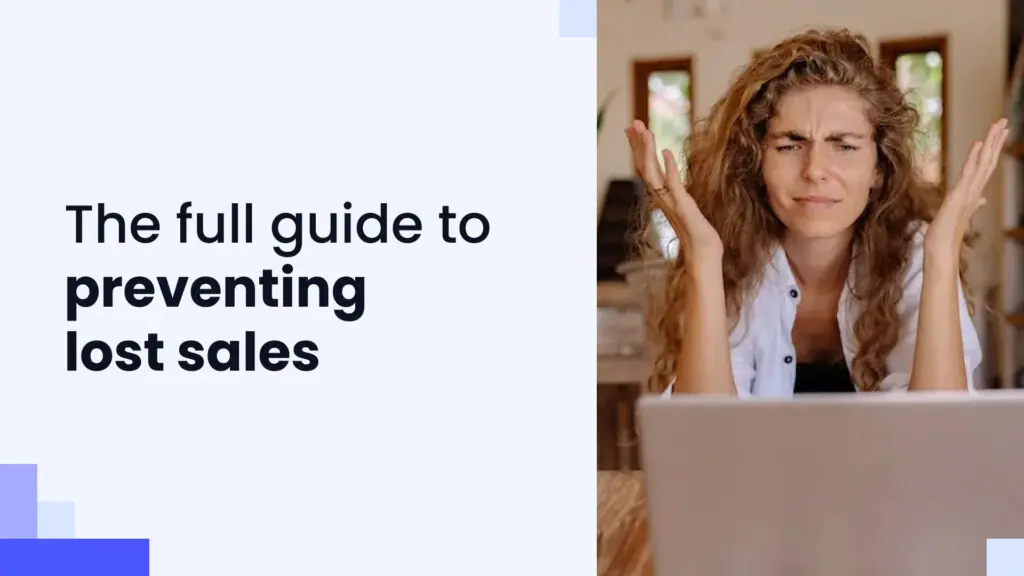It takes a lot of work to succeed and grow as an eCommerce seller. You need to find or create a product that sells, set up your supply chain, stock up on inventory, and market your product to consumers. After all of the time, effort, and capital that it takes to get your product out there, lost sales can really harm your business.
Fund your inventory with 8fig!
No matter how hard you try to prevent them, sometimes lost sales can’t be avoided. However, there are certainly ways to minimize them and reduce their effect on your business. Gaining an understanding of why you might be experiencing lost sales and finding strategies to manage them is a great place to start.
What is a lost sale?
A lost sale is just what it sounds like – an opportunity for a sale that fails to come to fruition. This can happen for a variety of reasons, from stockouts to a poorly designed checkout process. No matter the cause of a lost sale, however, it’s a loss of revenue for your business.
Every business experiences lost sales at one time or another. However, if you want to maximize your profits and improve your business, it’s a good idea to identify the cause and do your best to remedy it.
What are the most frequent causes of lost sales for eCommerce sellers?
If you want your online store to succeed, you need to understand how to capture customers’ interest and hold it until they complete their purchase. This starts from a well targeted and effective marketing campaign and ends with a streamlined checkout process. There are many steps throughout this process where you can lose a sale. Here are some of the most common causes for a lost sale for eCommerce businesses.
Poor inventory management and stockouts
Stockouts are one of the biggest obstacles to maximizing your profits and a common cause of lost sales. After all, in order to sell a product, you need to have it in stock.
Since today’s consumers expect fast service, they’ll expect any item they order to be delivered quickly, sometimes within a day or two. If you are out of stock and can’t deliver on that promise, your potential customers will look elsewhere. Most consumers aren’t willing to wait for a particular website to get their wares in stock and will turn to one of your competitors to fill their need.
We’ll ask a few quick questions to better understand your specific business needs. Then, we’ll build a funding plan tailored to your expenses.
Subscribe to the eCommerce newsletter for
top industry insights
In order to avoid these lost sales, do your best to avoid going out of stock. Maintaining optimal stock levels can be difficult, however. You don’t want to order too much inventory or your much-needed cash will be tied up in storage. Ordering too little, on the other hand, leads to stockouts. Therefore, it’s important to put some time into inventory management and accurately forecast demand. This will allow you to hold the right amount of inventory for your business and help you avoid losing sales due to running out of stock.
Make sure to take seasonality and holiday sales into account when forecasting demand and stocking up on goods. You may need to order your inventory well in advance to prepare for peak seasons.
Failure to set your product apart
When you’re trying to make a sale, it’s important to let potential customers know why they should choose your product instead of other options out there. That requires differentiating your product in some way. If your product doesn’t stand out or offer something different than the competition, you’re in danger of a lost sale.
Pay particular attention to differentiating your product or your company in your marketing campaigns in order to attract consumers looking for something different. Give them a good reason to choose your store instead of the competition, and you’ll be more likely to avoid lost sales.
Another good way to differentiate your product is to highlight a common customer pain point that your product solves. You can do this in your advertising campaigns as well as through content marketing like blog posts and emails. Setting your brand apart in this way is a great way to build trust and confidence in your brand and is a big help in minimizing lost sales.
Targeting the wrong audience
One of the biggest mistakes you can make as an eCommerce seller is not targeting the right audience. Naturally, this necessitates knowing your audience. It’s almost impossible to market to the right consumer when you have no data. So, take some time to monitor the actions of consumers across your industry. Once you gain an understanding of who will want to buy your product, you can put together a buyer persona, or an example of your ideal target customer.
Advertising to your buyer persona is a great way to ensure that you aren’t wasting your advertising dollars targeting the wrong audience. It will also help you improve your product and brand experience to better match the consumers most likely to purchase it.
Bad user experience
Pro tip
60% of consumers say they abandon online purchases due to poor user experience.
Make sure your website is simple, easy-to-use, and functional to minimize lost sales.
Consumers expect websites to load quickly and to be easy to navigate. If a potential customer has a bad experience on your website, they’re likely to click away. In one survey, 60% of consumers reported that they abandon purchases because of a poor user experience. It is therefore crucial that you make sure your website is simple, easy to use, and functional.
What’s more, a slow loading time can be a huge reason that customers leave your website before buying anything. In fact, according to another study, half of visitors abandon a website if it takes longer than 6 seconds to load. If your website takes too long to load, 45% of customers will walk away with a negative impression.
Long checkout process
Once a customer chooses the product they wish to purchase and add it to their cart, you want to get them to complete the checkout process as quickly as possible. The more steps are involved or the longer it takes to check out, the more opportunities they have to change their mind. In order to cut down on lost sales, make sure that the checkout process is fast, simple, and secure.
It’s also a good idea to offer a number of payment options, so that every customer can choose the one that best suits their needs. If a potential customer doesn’t have the ability to pay by their preferred method, they’re likely to find another seller that does give them that choice.
Lack of engagement with customers
Sometimes, potential customers need to be encouraged to make a purchase. Successfully turning browsing consumers into converting customers often requires building a relationship with them. You’ll want to nurture your potential customers, providing them with information and targeting them with well-made advertisements in order to engage with them.
Pay attention to your buyer’s journey and make sure to engage with them at each stage of the process. Staying with them in this way familiarizes them with your brand and product and lowers the chance of them turning to a competitor. A good customer engagement strategy is a sure way to influence their behavior and often ends up with a higher conversion rate.
Might also interest you:
How can you minimize lost sales?
The first step in minimizing lost sales is to identify the reasons why customers aren’t going through with their purchases. There are tools online to help you determine at what stage you lost sales. This is important feedback to consider so you can make changes to avoid those lost sales in the future.
The following are some proven methods to minimize lost sales.
Engage the customer
You may know your audience as an eCommerce seller, but are you engaging them? Many times, it takes more than one exposure to your product to convince a customer to visit your website, and more than one visit to convert. Provide them with free content about a pain point that your product solves, retarget them with personalized advertising, or encourage them to sign up for your newsletter. Building relationships with potential customers is a great way to minimize lost sales.
Forecast sales
Failure to accurately forecast demand and sales can be quite harmful to your business. If you don’t have the right products in stock when consumers are looking to buy, you’ll inevitably run into lost sales. Pay particular attention to seasonal products to make sure you place those inventory orders in time.
Stockouts not only lead to lost sales, they also lead to customer dissatisfaction and lost customers. If a potential customer can’t buy the item they want from your store, they’ll turn to a competitor. If they’re happy with their experience with your competitor, they’re unlikely to come back to your business again.
Popular content
View articles
Everyone likes a good sale. When potential customers feel that they can save a bit of money on a product, they’re more likely to go ahead and complete the purchase. Using marketing psychology can help out, too. Making customers feel that they’ll be missing out on a great deal if they don’t buy a product is a great place to start. You can also use social proof, showing them that other customers are buying the product. However, always keep your profit margins in mind. Discounting too heavily might increase sales but it can hurt you in the long run.
Make your products stand out
The internet is a big place, and there are always lots of options out there for consumers looking for a specific product. Therefore, it’s crucial that you find a way to make your product and brand stand out from the competition.
Convince potential customers that your product is the best option. Highlight a problem that your product can solve or emphasize a unique feature. You can also make your brand more attractive to consumers by pointing out your sustainable business practices or any other aspect of your brand that might appeal to your audience.
Be ready to deal with unexpected changes
No matter how hard you work to avoid lost sales, they’re bound to happen occasionally. ECommerce sellers know that things inevitably change quickly. From factory shutdowns to supply chain delays and disruptions to damaged shipments and extreme changes in demand, it’s important to be ready for anything.
Having enough cash flow on hand to stock up on inventory and deal with these unexpected setbacks can save your business. Therefore, many sellers turn to external eCommerce funding solutions, like 8fig.
8fig is a unique funding and growth partner designed exclusively for eCommerce sellers. We offer you continuous, flexible capital to help you grow your business and reach your full potential. Instead of one lump-sum of cash, 8fig provides you with ongoing cash injections aligned to your supply chain costs. This optimizes your cash flow so you know you’ll have enough capital for the next batch. You can also adjust your plan in real time to reflect the always changing needs of your business.
In addition to funding, 8fig also provides eCommerce sellers with invaluable tools and resources to help you take your business to the next level.
Ready to start growing your business? Sign up for an 8fig Growth Plan today!
Have article ideas, requests, or collaboration proposals? Reach out to us at editor@8fig.co – we’d love to hear from you.



